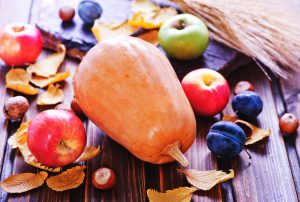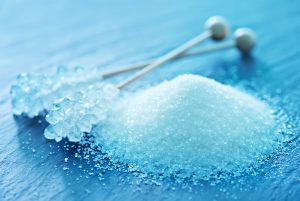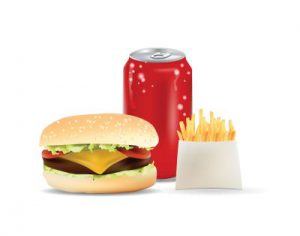The values for the three components of the carbohydrate are often taken from a variety of sources, mainly food analyses appearing in the scientific literature. Generally, for a single food entry, the fiber value is from one data source, the sugar values from another, and the starch value from a third. The total carbohydrate value is usually from the USDA Nutrient Data Laboratory database. Since the data were obtained from a variety of sources, and therefore a variety of food samples, the individual carbohydrate fractions do not necessarily equal the total carbohydrate.
Even if the carbohydrate values are all taken from the same source, there may be a difference between the total carbohydrate and the sum of the fractions. This is because the total carbohydrate for 100 grams of food is derived by subtracting the amount of fat, protein, ash, and water from 100 grams. Therefore, the resulting total carbohydrate may include compounds other than sugars, dietary fiber, and starch.
Additionally, the NCC Food and Nutrient Database contains fields for sucrose, glucose, fructose, lactose, maltose, and galactose. There are some other sugars in foods (e.g. oligosaccharides) that are not yet included in the database due to inadequate data.
All posts by NCC
How do I calculate nutrient intake from food and dietary supplement sources combined?
Overview
If dietary supplement use was assessed using the Dietary Supplement Assessment Module (DSAM), nutrient intakes from food and dietary supplement sources combined may be calculated using Output File data in File 04 (Intake Properties Totals File) and File 12 (DSAM Total 24-hour Supplement Intake File). File 04 contains total daily nutrient intake estimates from the 24-hour dietary recall record (e.g., total daily vitamin C intake from the 24-hour dietary recall record). File 12 includes total daily nutrient intake estimates from the DSAM interview (e.g., total daily vitamin C intake from the 24-hour dietary supplement recall interview). By summing nutrient intake estimates from File 04 and File 12, total daily intake of nutrients from food and supplement sources may be calculated (e.g., vitamin C intake from 24-hour dietary recall record + vitamin C intake from 24-hour dietary supplement recall interview = total vitamin C intake from all sources combined).
Nutrients and Food Components for Which Totals May be Calculated
Nutrients with common units and definitions in File 04 and File 12 may be combined to calculate total intake estimates. A listing of variable names and file locations (column numbers) for nutrients with the same units in File 04 and File 12 are provided herein to assist in this process (PDF). Comments are provided to explain the rationale for some of the combinations.
It is important to note that File 04 contains some nutrients and food components that are not included in File 12. For example, the variable ‘maltose’ is included in File 04 but is not available in File 12. Conversely, File 12 contains some nutrients and dietary supplement components that are not included in File 04. For example, the variable ‘chromium’ is included in File 12 but is not available in File 04. Consequently, total intake estimates from food and dietary supplement sources combined may not be calculated for these nutrients and food components.
It is also important to note that nutrients with different units or descriptions should not be combined unless conversion factors are available (see the Alerts and Footnotes in the PDF). For example, multiply the Synthetic Folate (folic acid) value in Supplements by a factor of 1.7 to convert to Dietary Folate Equivalents in Supplements or divide the Omega-3 Fatty Acids value in Supplements by 1000 to convert from milligrams to grams.
Dietary Supplement Intake Data Caveats
All nutrient values and other components assigned to dietary supplements in the DSAM database are limited to the information provided on the product’s Supplement Facts panel. Dietary supplement manufacturers have some discretion with respect to the information they provide on this panel. Most notably, they are not required to list on the Supplement Facts panel all of the nutrients the product contains. Since NCC does not calculate or impute nutrients for dietary supplements, the level of completeness for some nutrients and components may therefore be low. Due to this limitation, the nutrient totals may be under-estimated for some nutrients because the DSAM database does not contain the usual relationships to other nutrients or components.
Some examples of nutrients and other supplement components for which completeness may be an issue are as follows:
Amino Acids
The amount of protein contained in a ‘serving’ of a dietary supplement must be provided on the Supplement Facts panel if a product contains protein. The individual amino acids in a protein containing supplement may be listed, but inclusion on the Supplement Facts panel is not mandatory. As a result, amino acid information for protein containing products may be incomplete.
Fatty Acids
The amount of fat contained in a ‘serving’ of a dietary supplement must be provided on the Supplement Facts panel if a product contains fat. Likewise, the total saturated and trans fatty acid content must be listed. Other classes of fatty acids and individual fatty acids do not have to be provided. However, manufacturers may provide this information if they wish. Consequently, fatty acid information for fat containing products may be incomplete.
Soluble and Insoluble Fiber
The amount of fiber contained in a ‘serving’ of a dietary supplement must be provided on the Supplement Facts panel of fiber containing supplements. The amounts of soluble and insoluble fiber do not have to be provided. However, manufacturers may provide this information if they wish. As a result, soluble and insoluble fiber information may be incomplete for some fiber containing products.
Total Vitamin A
Starting in 2016 when the FDA published the final rule for the new Nutrition Facts panel for foods and Supplement Facts panel for dietary supplements, vitamin A could be included on product labels in either Retinol Activity Equivalents (RAE) (mcg) or International Units (IU). The new Supplement Facts panel, which manufacturers could begin using anytime between the final rule and mandatory implementation in 2020, requires vitamin A to be listed on the label in the unit of mcg RAE whereas the old label required listing vitamin A in IU. As a result of this labeling change, starting in NDSR 2020 vitamin A containing products in the DSAM database may include vitamin A values in either mcg RAE or IU.
There is no direct conversion factor from the vitamin A declared on labels in IU to mcg RAE, only individual conversion factors for provitamin A carotenoids and pre-formed vitamin (https://www.fda.gov/media/129863/download). Consequently, Total Vitamin A Activity (International Units) (IU) from Files 04 and 12 can be combined and Total Vitamin A Activity (Retinol Activity Equivalents) (mcg) from Files 04 and 12 can be combined but the two cannot be combined to calculate one Total Vitamin A value from foods and supplements.
Total Vitamin E
Starting in 2016 when the FDA published the final rule for the new Nutrition Facts panel for foods and Supplement Facts panel for dietary supplements, vitamin E could be included on product labels in either Total Alpha-Tocopherol (mg) or International Units (IU). The new Supplement Facts panel, which manufacturers could begin using anytime between the final rule and mandatory implementation in 2020, requires vitamin E to be listed on the label in the unit of Total Alpha-Tocopherol (mg) whereas the old label required listing vitamin E in IU. As a result of this labeling change, starting in NDSR 2020 vitamin E containing products in the DSAM database may include vitamin E values in either Total Alpha-Tocopherol (mg) or IU.
Without knowing the form of vitamin E (i.e. natural RRR-α-tocopherol vs. synthetic all-rac-α-tocopherol), there is no direct conversion factor from the vitamin E declared on labels in IU to mg of Total Alpha-Tocopherol. Consequently, Vitamin E (International Units) (IU) from Files 04 and 12 can be combined and Vitamin E (Total Alpha-Tocopherol) (mcg) from Files 04 and 12 can be combined but the two cannot be combined to calculate one Total Vitamin E value from foods and supplements.
Why aren’t all of my user recipes displayed in the Food Search window?
It may be that the Include in Food Search checkbox on the Header tab of the user recipe has not been selected. Return to the project containing the user recipe and look on the recipe Header. Select the Include in Food Search checkbox. When you type the name of the user recipe in the Search by pane it should now appear.
If the Include in Food Search checkbox is checked and the user recipe still does not appear, select the User Recipe radio button followed by the Search button in the Food Search window. If you have more than one user-recipe project, select the appropriate project. Any user recipes which contain incomplete or missing foods will not be displayed.
When should I use a user recipe?
The decision to take advantage of the user-recipe feature should be made prior to the start of a study. Are there special recipes your study population will be consuming that are not in the NCC database? Will your study participants be provided with recipes as an intervention strategy? Are you doing menu analysis for which recipes are available? These examples illustrate instances where user recipes can be created prior to study start-up, making them available for immediate insertion into intake records and menus.
The user recipe feature can also be a useful tool for data entry of missing or new foods. When you receive a resolution from NCC that has several ingredients and is a commonly consumed food, enter the resolution as a user recipe and it will be available for use and reuse in subsequent intake records.
Note: Any user recipes that are created to match specific nutrient data should be reviewed with each new release of the NCC database.
I’m getting a new computer. What should I do with NDSR?
First, make sure you backup all NDSR data and store it in a safe place. Next, email ndsrhelp@umn.edu to unregister the license, a process similar to getting a password. Uninstall NDSR on your old computer, then install it on your new computer and contact NCC for a new password.
See the Chapter 2, Installation in the NDSR User Manual.
Is there a limit to the number of records I can have in one NDSR project?
Although there is not an official limit to the number of records in a project, NCC recommends that users limit the project size to approximately 500 records, this is especially true if records include DSAM data.
Is there a list of all the foods in NDSR?
When NDSR is installed, a Foods File is downloaded to your computer (along with a series of files found in an Additional Files folder). The Additional Files folder is discussed in Appendix 18 of the NDSR User Manual.
For Windows 10 users, the location is C:\Users\Public\Public Documents\NCC\NDSR XXXX\Additional Files\Database Documentation\FoodsXXXX.
The Program Data folder in Windows 10 is often hidden. To unhide the folder, go to Folder and Search Options > Folder Options > View tab and select the Show Hidden Files, Folders, and Drives radio button.
The Foods File provides a complete list of NDSR food descriptions, Food IDs, food group assignments and serving count sizes.
How do I cite NDSR?
In the Methods section of your manuscript please include one of the following statements.
-
- Citation for NDSR single version:
Dietary intake data were collected and analyzed using Nutrition Data System for Research software version _____, (date) developed by the Nutrition Coordinating Center (NCC), University of Minnesota, Minneapolis, MN.
- Citation for NDSR multiple versions:
To reflect the marketplace throughout the study, dietary intake data were collected using Nutrition Data System for Research software versions _____ and _____, developed by the Nutrition Coordinating Center (NCC), University of Minnesota, Minneapolis, MN. Final calculations were completed using NDSR version _____, (date).
In the References section of your manuscript these journal articles may be used to refer to the nutrient database that NDSR accesses.- Schakel SF. Maintaining a nutrient database in a changing marketplace: Keeping pace with changing food products – A research perspective. J Food Comp and Anal. 2001;14:315-322.
- Schakel SF, Buzzard IM, Gebhardt SE. Procedures for estimating nutrient values for food composition databases. J Food Comp and Anal. 1997;10:102-114.
- Schakel SF, Sievert YA, Buzzard IM. Sources of data for developing and maintaining a nutrient database. J Am Diet Assoc. 1988;88:1268-1271.
- Citation for NDSR single version:
Can NDSR be used to assess nutrient intakes of individuals living outside the U.S.?
Researchers have used NDSR for studies in countries outside the U.S. Special procedures are recommended, because the nutrient composition values for foods in NDSR are based on U.S. foods.
Nutrient values for some food items may be representative of those available in other countries (e.g., nutrient content of an apple in the U.S. and an apple available in another country may be comparable). However, values are likely not comparable for many foods due to different food fortification practices across countries, use of different cultivars of plants, and differences in food ingredient and preparation practices. An additional issue is that some food descriptors vary across countries. For example, in the U.S. ‘biscuit’ refers to a fat-rich leavened baked good generally served with a meal. In contrast, in many other countries ‘bisquit’ refers to a sugar-sweetened baked good served as a snack or dessert.
NCC News Bite | October 2022
This edition contains the following articles:
- Thank You for Completing the Survey
- Answer to Question Frequently Asked About Added Sugars Variables in NDSR Output Files
- Why Aren’t Regional Fast Food Chains or Non-Fast Food Restaurants Included in NDSR?
- Nutrition Evaluation of the Emergency Meals-to-You Program (eMTY)
Thank You for Completing the Survey
Many thanks to those of you who completed our recent Client Survey! We are reviewing the results and your suggestions closely to help improve NDSR and our services. Some of the questions and requests that came in through the survey will be answered in future issues of the NCC News Bite. If you have any other questions about using NDSR, we invite you to email us at NDSRhelp@umn.edu anytime. We like hearing from you, and you don’t have to wait for the next survey to submit other questions. Our User Support team is available to help answer your questions.
Answer to Question Frequently Asked About Added Sugars Variables in NDSR Output Files
NDSR includes two Added Sugars variables in the NDSR output files–Added Sugars (by Available Carbohydrate) and Added Sugars (by Total Sugars), and often we are asked to explain the difference between the two. So, here it is, starting with the general definition of Added Sugars.
Added Sugars are those sugars and syrups added to foods during food preparation or commercial food processing. Ingredients designated as “added sugar” foods in the NCC database include: white sugar (sucrose), brown sugar, powdered sugar, honey, molasses, pancake syrup, corn syrups, high fructose corn syrups, invert sugar, invert syrup, malt extract, malt syrup, fructose, glucose (dextrose), galactose, and lactose. They do not include mono- and disaccharides occurring naturally in foods, such as lactose in milk or fructose in fruit.
The Added Sugars (by Available Carbohydrate) value assigned by NCC to foods considered to be sources of added sugars represents the amount of available carbohydrate present in the food, which includes saccharides of all types. Mono- and disaccharides along with saccharides with a higher degree of polymerization that are resistant to digestion (e.g., trehalose) are included under this definition.
For example, corn syrups with different Dextrose Equivalency (DE) contain a high amount of trisaccharides and other higher saccharides (approximately 75%) due to the incomplete hydrolysis of the cornstarch. These more complex sugars are included under Added Sugars (by Available Carbohydrate).
The Added Sugars (by Total Sugars) value assigned by NCC to foods considered to be sources of added sugars represents the amount of total sugars present in the food, which includes only mono- and disaccharides. The Added Sugars (by Total Sugars) variable aligns with how this food component is defined by the U.S. Food and Drug Administration for Nutrition Fact labeling.
Do you have questions about other nutrients and food components in NDSR output files? Note that the NDSR User Manual includes detailed nutrient information in Appendix 11. Also, detailed information may be found on our website (definitions and units can be viewed by clicking on category titles).
Why Aren’t Regional Fast Food Chains or Non-Fast Food Restaurants Included in NDSR?
The NCC Food and Nutrient Database currently includes menu items for 23 leading fast food restaurants. Nonetheless, we’re often asked why we don’t include more regional fast food chains or popular non-fast food restaurants in the database. The answer to this question primarily relates to resource constraints, as adding and updating restaurant menu items is labor intensive. Also, in some cases information needed to add menu items to our database are lacking (e.g. restaurant does not provide ingredient listing or basic nutrient content information for menu items).
To assist you with data entry of foods reported from regional fast food chains and non-fast food restaurants that aren’t found in the database, we suggest you look for a close match in the database, either generically (from the mixed dish, sandwich, or salad hierarchy) or from a restaurant that we do have. Examples are 1) if a Starbucks grande café latte is reported – look for the generic café latte and choose the appropriate FSU; 2) the Applebee’s Oriental Chicken Salad – look in the salad hierarchy for the Asian chicken salad; 3) a Carl’s Jr. hamburger – choose the Hardee’s hamburger; and 4) for a blooming onion – enter as ‘onion rings’ and have the participant estimate it as a portion of onion rings. For foods that are reported often, and for which there isn’t a database option that fits your needs, you can submit it for a New Food Resolution and note under “Other Information” that you would like the food considered for addition to the database. Please feel free to contact User Support at NDSRhelp@umn.edu if you have any additional suggestions for generic restaurant food items to add to the database.
Nutrition Evaluation of the Emergency Meals-to-You Program (eMTY)
NCC was pleased to carry out an analysis of the nutritional quality of meals delivered to rural children in households with lower income as part of the United States Department of Agriculture (USDA) Emergency Meals-to-You (eMTY) program. Over the summer of 2020 the eMTY program provided over 37 million meals to 275,000 rural children in 43 states through home-delivered boxes of shelf-stable food. The program was run by the Baylor Collaborative on Hunger and Poverty in partnership with Chartwells K12, PepsiCo Food for Good, and McLane Global. Every two weeks, a box containing food for 10 breakfasts and 10 lunches—enough for two weeks—was delivered to the student’s home or to a centralized location when necessary. The meals were to be planned to meet the USDA Summer Food Service Program (SFSP) nutrition standards. Results of the nutrition evaluation of the eMTY program are available. Click here for the full report, or download the executive summary here.
Do you have menus that need to be evaluated for nutritional quality? NCC Research Services is available to conduct menu analysis through our Menu Analysis service. Contact Kerrin Brelje at kbrelje@umn.edu for more information or a price quote.




